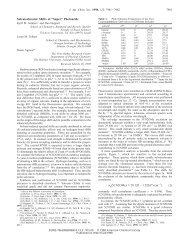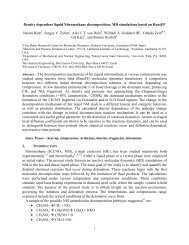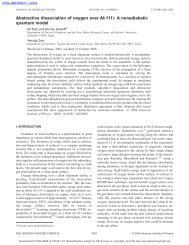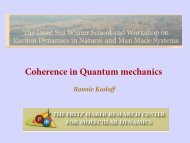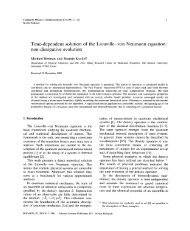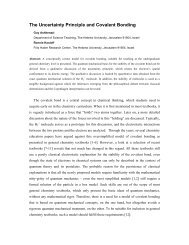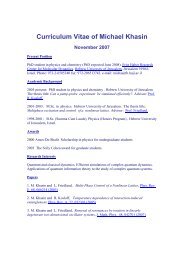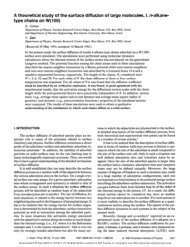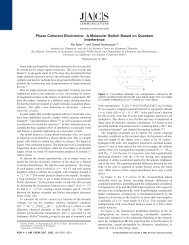Maximum work in minimum time from a ... - ResearchGate
Maximum work in minimum time from a ... - ResearchGate
Maximum work in minimum time from a ... - ResearchGate
You also want an ePaper? Increase the reach of your titles
YUMPU automatically turns print PDFs into web optimized ePapers that Google loves.
PAPER www.rsc.org/pccp | Physical Chemistry Chemical Physics<br />
<strong>Maximum</strong> <strong>work</strong> <strong>in</strong> m<strong>in</strong>imum <strong>time</strong> <strong>from</strong> a conservative quantum system<br />
Peter Salamon,* a Karl He<strong>in</strong>z Hoffmann, b Yair Rezek c and Ronnie Kosloff c<br />
Received 15th September 2008, Accepted 30th October 2008<br />
First published as an Advance Article on the web 18th December 2008<br />
DOI: 10.1039/b816102j<br />
This paper considers the problem of obta<strong>in</strong><strong>in</strong>g maximum <strong>work</strong> <strong>from</strong> a conservative quantum<br />
system correspond<strong>in</strong>g to a given change <strong>in</strong> an external parameter <strong>in</strong> the Hamiltonian. The<br />
example we present is a non-<strong>in</strong>teract<strong>in</strong>g collection of harmonic oscillators with a shared frequency<br />
o which changes <strong>from</strong> a given <strong>in</strong>itial to a given f<strong>in</strong>al value. The example is <strong>in</strong>terest<strong>in</strong>g for its role<br />
<strong>in</strong> experiments at ultra-low temperatures and for prob<strong>in</strong>g f<strong>in</strong>ite-<strong>time</strong> versions of the third law of<br />
thermodynamics. It is also the simplest system display<strong>in</strong>g quantum friction, which represents loss<br />
mechanisms <strong>in</strong> any reversible prelude to a thermal process. The example leads to a new type of<br />
availability. It is also the first example of a m<strong>in</strong>imum <strong>time</strong> for transitions between thermal states<br />
of a thermodynamic system.<br />
Introduction<br />
The concept of Gibbs free energy is familiar to most readers.<br />
The change <strong>in</strong> free energy is the maximum <strong>work</strong> that could be<br />
captured <strong>from</strong> allow<strong>in</strong>g some specified change <strong>in</strong> a thermodynamic<br />
system to take place or the m<strong>in</strong>imum <strong>work</strong> needed to<br />
make the change happen. The proviso that the change must<br />
happen at constant temperature and pressure is needed. Without<br />
this proviso, the change <strong>in</strong> a more general quantity called the<br />
availability has this same optimum <strong>work</strong> characterization.w<br />
The change of availability equals the <strong>work</strong> extracted <strong>in</strong> any<br />
reversible process between the <strong>in</strong>itial and f<strong>in</strong>al states. If any<br />
dissipation is present, the change <strong>in</strong> availability is more than the<br />
<strong>work</strong> extracted; this statement is one form of the second law of<br />
thermodynamics.<br />
This paper describes a quantum control problem where a<br />
totally new k<strong>in</strong>d of availability appears. It is the availability<br />
associated with a specified change <strong>in</strong> an external parameter <strong>in</strong><br />
the Hamiltonian describ<strong>in</strong>g the system. Such <strong>time</strong> dependent<br />
mechanics is perfectly reversible. The <strong>work</strong> extracted equals<br />
the change <strong>in</strong> the energy of the system. Yet we f<strong>in</strong>d that some<br />
ways of carry<strong>in</strong>g out the change <strong>in</strong> the external parameter<br />
result <strong>in</strong> more <strong>work</strong> extracted than other ways.<br />
Another new feature of our ‘‘reversible’’ availability is that<br />
the <strong>time</strong> duration of the process plays a crucial role. In fact we<br />
f<strong>in</strong>d that there is a m<strong>in</strong>imum <strong>time</strong> for achiev<strong>in</strong>g this maximum<br />
<strong>work</strong> and without constra<strong>in</strong><strong>in</strong>g the <strong>time</strong>, our extension of<br />
availability to this situation becomes mean<strong>in</strong>gless. It has<br />
previously been po<strong>in</strong>ted out <strong>in</strong> great generality 1 that f<strong>in</strong>ite<br />
<strong>time</strong> constra<strong>in</strong>ts typically force us to forego some of the<br />
available <strong>work</strong> <strong>from</strong> a process. The fact that this applies even<br />
a<br />
Department of Mathematical Science, San Diego State University,<br />
San Diego, California, 92182, USA. E-mail: salamon@sdsu.edu<br />
b<br />
Institute fur Physik, Technical University of Chemnitz, D-09107<br />
Chemnitz, Germany<br />
c<br />
Fritz Haber Research Center for Molecular Dynamics, Hebrew<br />
University of Jerusalem, Jerusalem, 91904, Israel<br />
w Availability is also called exergy.<br />
when all processes considered are reversible, goes beyond the<br />
considerations <strong>in</strong> that paper.<br />
The specific example we treat <strong>in</strong> this paper is the optimal<br />
control problem of cool<strong>in</strong>g an ensemble of non-<strong>in</strong>teract<strong>in</strong>g<br />
particles <strong>in</strong> a harmonic potential. The Hamiltonian of this<br />
system is controlled by chang<strong>in</strong>g the curvature of the conf<strong>in</strong><strong>in</strong>g<br />
potential by means of an external field. This amounts to<br />
controll<strong>in</strong>g the (shared) frequency o of the oscillators and is<br />
described by the <strong>time</strong> dependent Hamiltonian H ˆ (o(t)).<br />
S<strong>in</strong>ce we are deal<strong>in</strong>g with a conservative mechanical system,<br />
the change <strong>in</strong> the energy of the system is the <strong>work</strong> done by the<br />
system. Thus for a given <strong>in</strong>itial state, maximiz<strong>in</strong>g the <strong>work</strong><br />
done is equivalent to m<strong>in</strong>imiz<strong>in</strong>g the f<strong>in</strong>al energy of the system.<br />
The m<strong>in</strong>imum value of the f<strong>in</strong>al energy is determ<strong>in</strong>ed by<br />
the value of the von Neumann entropy SVN, which must<br />
necessarily stay constant dur<strong>in</strong>g our reversible process. There<br />
are many ways to reach the m<strong>in</strong>imum energy subject to this<br />
constra<strong>in</strong>t, the classical example be<strong>in</strong>g the quantum adiabatic<br />
process 2 <strong>in</strong> which o is changed <strong>in</strong>f<strong>in</strong>itesimally slowly. Mov<strong>in</strong>g<br />
at f<strong>in</strong>ite rates excites parasitic oscillations <strong>in</strong> our system; a fact<br />
that has been termed quantum friction 3,4 and can be attributed<br />
to the Hamiltonian at <strong>time</strong> t and at <strong>time</strong> a t not commut<strong>in</strong>g,<br />
[H ˆ (t),H ˆ (t 0 )] a 0. When the process duration needs to be fast,<br />
we cannot avoid quantum frictional processes leav<strong>in</strong>g some<br />
energy <strong>in</strong> parasitic oscillations. This is the reason we fail to<br />
capture the full classical availability; some of it is left beh<strong>in</strong>d <strong>in</strong><br />
such oscillations. Its ‘‘loss’’ owes partly to the fact that the<br />
reversible process we envision is a prelude to a thermal process<br />
and that dur<strong>in</strong>g thermal processes, the energy <strong>in</strong> the parasitic<br />
oscillations leaves the system as heat. It turns out, however,<br />
that there exist fast frictionless controls and we f<strong>in</strong>d the fastest<br />
such control below: the m<strong>in</strong>imum <strong>time</strong> for extract<strong>in</strong>g the<br />
maximum <strong>work</strong>.<br />
While the problem is <strong>in</strong>terest<strong>in</strong>g <strong>in</strong> its own right, it plays a<br />
pivotal role as the adiabatic branch <strong>in</strong> a cool<strong>in</strong>g cycle 5 <strong>in</strong> which<br />
the adiabatic branch is followed by a thermal branch. Such<br />
cycles can be used to probe the unatta<strong>in</strong>abilitity of absolute<br />
zero. 6 Our results applied to such cycles imply a f<strong>in</strong>ite <strong>time</strong><br />
version of the third law of thermodynamics. Specifically, they<br />
This journal is c the Owner Societies 2009 Phys.Chem.Chem.Phys., 2009, 11, 1027–1032 | 1027
imply that as the temperature of the cold bath Tc approaches<br />
zero, the cool<strong>in</strong>g rate must approach zero as T 3/2<br />
c . 6,7<br />
Our problem is also the first example of another important<br />
but until now unconsidered question for thermodynamics:<br />
What is the m<strong>in</strong>imum <strong>time</strong> for controll<strong>in</strong>g a system to move<br />
between two thermal states? The question is loaded with<br />
subtlety; thermal equilibrium is traditionally approached only<br />
asymptotically so ask<strong>in</strong>g how one can get to another equilibrium<br />
state <strong>in</strong> m<strong>in</strong>imum <strong>time</strong> should lead only to paradoxes. Not so<br />
for our problem and the answer h<strong>in</strong>ts at possible ways of<br />
attack<strong>in</strong>g the question <strong>in</strong> general. The m<strong>in</strong>imum <strong>time</strong> problem<br />
has obvious importance <strong>in</strong> a number of contexts. As a familiar<br />
example <strong>from</strong> solid state chemistry, consider the m<strong>in</strong>imum <strong>time</strong><br />
problem of <strong>in</strong>duc<strong>in</strong>g a transition <strong>from</strong> graphite to diamond.<br />
Our calculations below f<strong>in</strong>d the first closed form expression<br />
for the m<strong>in</strong>imum <strong>time</strong> between two thermal states of any<br />
thermodynamic system.<br />
There have been many studies explor<strong>in</strong>g f<strong>in</strong>ite <strong>time</strong> effects<br />
on thermodynamic processes. 8–11 The example we solve here<br />
extends our understand<strong>in</strong>g of the f<strong>in</strong>ite <strong>time</strong> third law and of<br />
the m<strong>in</strong>imum <strong>time</strong> problem. It also <strong>in</strong>troduces a new form of<br />
f<strong>in</strong>ite <strong>time</strong> availability.<br />
The system<br />
Consider an ensemble of non-<strong>in</strong>teract<strong>in</strong>g particles bound by a<br />
shared harmonic potential well. We control the curvature of<br />
the potential o(t). The energy of an <strong>in</strong>dividual particle is<br />
represented by the Hamiltonian<br />
^H ¼ 1<br />
2m ^ P 2 þ 1<br />
2 moðtÞ2 2<br />
Q^ : ð1Þ<br />
where m is the mass of the particle, and Qˆ and Pˆ are the<br />
momentum and position operators. We will assume that the<br />
system is <strong>in</strong>itially <strong>in</strong> thermal equilibrium<br />
^r ¼ 1<br />
Z e b ^H<br />
: ð2Þ<br />
It then follows that the state of the system at any <strong>time</strong> dur<strong>in</strong>g<br />
the process is a generalized Gibbs state of the canonical<br />
form, 12–16<br />
^r ¼ 1<br />
Z eg^a2 e b ^H g ^a<br />
e y2<br />
; ð3Þ<br />
where aˆ w and aˆ are the (<strong>time</strong> dependent) rais<strong>in</strong>g and lower<strong>in</strong>g<br />
operators of the harmonic oscillator. Note that this <strong>in</strong>cludes<br />
thermal states, which are obta<strong>in</strong>ed when g =0.<br />
The dynamics is generated by the externally driven <strong>time</strong><br />
dependent Hamiltonian Hˆ (o(t)). Our description is based on<br />
the Heisenberg picture <strong>in</strong> which our operators are <strong>time</strong><br />
dependent. The equation of motion for an operator Oˆ of the<br />
<strong>work</strong><strong>in</strong>g medium is:<br />
d ^ OðtÞ i<br />
¼<br />
dt h ½ ^HðtÞ; ^ OðtÞŠ þ @ ^ OðtÞ<br />
: ð4Þ<br />
@t<br />
The canonical state (3) is fully characterized by the frequency<br />
o and the expectation values of three <strong>time</strong>-dependent<br />
operators: ^H ¼ 1<br />
2m ^ P 2 þ 1<br />
2mo2 ^ Q 2 , ^L ¼ 1<br />
2m ^ P 2<br />
1<br />
2mo2 ^ Q 2 , and<br />
^C ¼ o<br />
2ð ^ Q ^P þ ^ P ^QÞ (the Hamiltonian, the Lagrangian, and a<br />
position-momentum correlation). These three operators form<br />
a Lie algebra and thus completely characterize the <strong>time</strong><br />
evolution generated by Hˆ(o(t)) which is an element of this<br />
algebra. Thermal equilibrium (Cf. eqn (2)) is characterized by<br />
hLˆi = hCˆ i =0.<br />
Substitut<strong>in</strong>g these operators <strong>in</strong>to our equation of motion<br />
(4) and tak<strong>in</strong>g expectation values leads to three l<strong>in</strong>ear coupled<br />
differential equations, describ<strong>in</strong>g the dynamics that we need<br />
to control<br />
_E ¼ _o<br />
ðE LÞ ð5Þ<br />
o<br />
_L ¼ _o<br />
ðE LÞ 2oC ð6Þ<br />
o<br />
_C ¼ 2oL þ _o<br />
C ð7Þ<br />
o<br />
where we have adopted the notation L = hLˆi and C = hCˆ i<br />
and switched to E = hHˆi to free up the symbol H for our<br />
optimal control Hamiltonian <strong>in</strong> the sections to follow. To cast<br />
our equations <strong>in</strong>to the form required by optimal control<br />
theory, we augment our dynamical eqns (10)–(12) by <strong>in</strong>troduc<strong>in</strong>g<br />
an additional dynamical equation<br />
_o ¼ ou ð8Þ<br />
where u is our control variable and x =(o,E,L,C) are our<br />
state variables. Us<strong>in</strong>g this new equation to elim<strong>in</strong>ate _o <strong>from</strong><br />
eqns (10)–(12) our dynamical equations are all of the form<br />
_x =(x,u),<br />
_o ¼ f1ðx; uÞ ¼ou ð9Þ<br />
E˙ = f 2(x,u) =u(E L) (10)<br />
_L = f3(x,u) = u(E L) 2oC (11)<br />
C˙ = f4(x,u) =2oL + uC (12)<br />
as required for the formalism of optimal control.<br />
The functions o(t) achievable us<strong>in</strong>g our control, do not<br />
limit the size of _o which means that we will have occasion<br />
to consider discont<strong>in</strong>uous jumps <strong>in</strong> o (u = N). The<br />
eqns (9)–(12) do not apply to such jumps. Rather for a jump<br />
o1 - o2 we must require<br />
E2 ¼ 1<br />
2 ðE1 þ L1Þþ 1<br />
2 ðE1 L1Þ o2 2<br />
o 2 1<br />
L2 ¼ 1<br />
2 ðE1 þ L1Þ<br />
o2<br />
C2 ¼ C1<br />
o1<br />
1<br />
2 ðE1 L1Þ o2 2<br />
o 2 1<br />
ð13Þ<br />
ð14Þ<br />
ð15Þ<br />
These equations follow <strong>from</strong> not<strong>in</strong>g that dur<strong>in</strong>g the jump Q ˆ<br />
and P ˆ are constant. Thus we can express E = hHˆi, L = hLˆi,<br />
and C = hC ˆ i before and after the jump <strong>in</strong> terms of Q ˆ and P ˆ<br />
and then elim<strong>in</strong>ate Q ˆ and P ˆ <strong>from</strong> the resultant equations.<br />
1028 | Phys. Chem. Chem. Phys., 2009, 11, 1027–1032 This journal is c the Owner Societies 2009
A special control correspond<strong>in</strong>g to a ‘‘wait’’ condition<br />
_o ¼ u ¼ 0 will play an important part <strong>in</strong> our discussion below.<br />
For this case the eqns (9)–(12) <strong>in</strong>tegrate to<br />
o(t) =o(0) (16)<br />
E(t) =E(0) (17)<br />
L(t) = cos(2ot)L(0) s<strong>in</strong>(2ot)C(0) (18)<br />
C(t) = s<strong>in</strong>(2ot)L(0) + cos(2ot)C(0). (19)<br />
Dur<strong>in</strong>g such waits, the variables L and C oscillate <strong>in</strong> <strong>time</strong> with<br />
constant L 2 + C 2 and with angular frequency 2o. This is the<br />
parasitic oscillation referred to <strong>in</strong> the <strong>in</strong>troduction.<br />
S<strong>in</strong>ce any o(t) represents Hamiltonian dynamics, the<br />
von Neumann entropy of the system is perforce constant.<br />
This entropy is given by 6<br />
where<br />
SVN ¼ ln<br />
ffiffiffiffiffiffiffiffiffiffiffiffi<br />
X 1<br />
r !<br />
þ<br />
4<br />
ffiffiffiffi p<br />
X as<strong>in</strong>h<br />
pffiffiffiffi<br />
X<br />
X 1<br />
!<br />
4<br />
ð20Þ<br />
X ¼ E2 L2 C2 h 2 o2 : ð21Þ<br />
We would expect the entropy to be a function of a comb<strong>in</strong>ation<br />
of E,L,C which is itself a scalar under unitary transformations<br />
<strong>in</strong>duced by the operator set. Such a comb<strong>in</strong>ation is provided by<br />
X (ref. 17, p. 47). We note that s<strong>in</strong>ce SVN is a monotonic<br />
function of X, constancy of SVN implies that X must stay<br />
constant.<br />
The m<strong>in</strong>imum energy problem<br />
As noted above, maximiz<strong>in</strong>g the <strong>work</strong> output is equivalent to<br />
m<strong>in</strong>imiz<strong>in</strong>g the f<strong>in</strong>al energy. An optimal control formulation<br />
of the m<strong>in</strong>imum f<strong>in</strong>al energy problem leads to a s<strong>in</strong>gular<br />
problem 18,19 for which the formalism of optimal control gives<br />
no answer. This can be understood physically s<strong>in</strong>ce any<br />
trajectory is part of an optimal one. To see this, we beg<strong>in</strong> by<br />
not<strong>in</strong>g that the m<strong>in</strong>imum energy that can be reached by any<br />
control start<strong>in</strong>g <strong>from</strong> the thermal state (o,E,L,C)=(oi,Ei,0,0) must have X = E 2 i /h 2 o 2 i . S<strong>in</strong>ce X stays constant, the value of<br />
of sets the value of E 2 f L 2 f C 2 f . It follows that to make Ef as<br />
small as possible, the f<strong>in</strong>al state should be another thermal<br />
state, i.e., Lf = Cf = 0. The m<strong>in</strong>imum f<strong>in</strong>al energy is Ef ¼ of o<br />
Ei<br />
i<br />
for the thermal state with bf ¼ oi o b<br />
f i. This energy can be reached<br />
by any control that changes the frequency o <strong>in</strong>f<strong>in</strong>itely slowly. 2<br />
Any f<strong>in</strong>ite rate control start<strong>in</strong>g <strong>from</strong> a thermal state moves us<br />
away <strong>from</strong> such a state as seen by exam<strong>in</strong><strong>in</strong>g the dynamical<br />
eqns (10)–(12) with L = C = 0 but with _oa0. The trick to<br />
reach<strong>in</strong>g the m<strong>in</strong>imum energy is to move back to a state with<br />
L = C = 0 at the f<strong>in</strong>al <strong>time</strong>. There are many ways to do this.<br />
For example, 6 we can use the control<br />
2lnðof=oiÞ<br />
uðtÞ ¼ ffiffiffiffiffiffiffiffiffiffiffiffiffiffiffiffiffiffiffiffiffiffiffiffiffiffiffiffiffiffiffiffiffiffiffiffiffi<br />
4p2 þ½lnðoi=ofÞŠ 2<br />
q oðtÞ ð22Þ<br />
which can be solved analytically for explicit x(t) and reaches<br />
the desired f<strong>in</strong>al state <strong>in</strong> <strong>time</strong><br />
ffiffiffiffiffiffiffiffiffiffiffiffiffiffiffiffiffiffiffiffiffiffiffiffiffiffiffiffiffiffiffiffiffiffiffiffiffiffiffi<br />
ð1 oi=ofÞ 4p<br />
t ¼ 2 þ½logðoi=ofÞŠ 2<br />
q<br />
: ð23Þ<br />
2oi logðoi=ofÞ<br />
Once we have one such solution, any trajectory can be part of<br />
a trajectory that reaches this f<strong>in</strong>al state. For example, we can<br />
simply reverse the trajectory and then follow eqns (22)–(23).<br />
This is no longer true however when we constra<strong>in</strong> the <strong>time</strong>,<br />
s<strong>in</strong>ce then we may not have enough <strong>time</strong> to reverse the<br />
trajectory or perhaps even to follow the trajectory <strong>in</strong><br />
eqns (22)–(23). In fact, once we ask for the m<strong>in</strong>imum <strong>time</strong><br />
solution, we get an essentially unique answer. This is described<br />
<strong>in</strong> the follow<strong>in</strong>g section.<br />
The m<strong>in</strong>imum <strong>time</strong> problem<br />
Our optimal control problem is then to m<strong>in</strong>imize the <strong>time</strong><br />
Z<br />
Z<br />
t = f0(x,u)dt = dt (24)<br />
subject to the constra<strong>in</strong>ts represented by the dynamical<br />
eqns (9)–(12), the <strong>in</strong>equalities om<strong>in</strong> r o(t) r omax, the <strong>in</strong>itial<br />
state (o i,E i,0,0), and the f<strong>in</strong>al state (o f,E f,0,0). The argument<br />
<strong>in</strong> the previous section <strong>in</strong>sures that such trajectories exist; here<br />
we seek the m<strong>in</strong>imum <strong>time</strong> trajectory.<br />
The optimal control Hamiltonian 20 is<br />
H ¼ X4<br />
n¼0<br />
lnfnðx; uÞ<br />
¼ l0 þ l1uo þ l2uðE LÞ l3ðuðE LÞþ2oCÞ<br />
þ l4ð2oL þ uCÞ ð25Þ<br />
where the l’s are conjugate variables closely related to the<br />
Lagrange multipliers <strong>in</strong> a Lagrangian formulation. Note that<br />
the optimal control Hamiltonian is l<strong>in</strong>ear <strong>in</strong> the control u. To<br />
emphasize this, we group the terms conta<strong>in</strong><strong>in</strong>g u and f<strong>in</strong>d<br />
H =[l1o +(l2 l3)(E L)]u +[l0 +2o(l4L l3C)](26)<br />
= su + a (27)<br />
wherewehave<strong>in</strong>troducedthetermss = s(x,l) anda = a(x,l)<br />
for the coefficients of H viewed as a l<strong>in</strong>ear polynomial <strong>in</strong> our<br />
control u. The Pontryag<strong>in</strong> maximality pr<strong>in</strong>ciple 20 tells us that at<br />
any <strong>in</strong>stant, the value of the control must maximize H. Thus when<br />
the switch<strong>in</strong>g function s is positive, u must be as large as possible<br />
and when s is negative, u must be as small as possible. S<strong>in</strong>ce away<br />
<strong>from</strong> the boundaries set by the <strong>in</strong>equalities o m<strong>in</strong> r o(t) r o max<br />
the value of u is not constra<strong>in</strong>ed, this amounts <strong>in</strong> our problem to<br />
jumps <strong>in</strong> o. This can be seen by consider<strong>in</strong>g the problem with<br />
|u(t)| r umax and lett<strong>in</strong>g umax - N. Such jumps must term<strong>in</strong>ate<br />
on the boundary arcs o(t) =omax or o(t) =om<strong>in</strong> which can be<br />
used as segments of the optimal trajectory. In addition to jumps<br />
and boundary arcs, the optimal control for such problems can<br />
also have s<strong>in</strong>gular branches along which the switch<strong>in</strong>g function<br />
s vanishes identically over a <strong>time</strong> <strong>in</strong>terval. These are characterized<br />
by sðtÞ ¼ _sðtÞ ¼€sðtÞ¼ ¼0, which usually suffice to determ<strong>in</strong>e<br />
the optimal control u*(t) along such arcs. That is not the<br />
case here; the equations that result <strong>from</strong> sett<strong>in</strong>g s and all its<br />
derivatives identically to zero do not determ<strong>in</strong>e the control. While<br />
This journal is c the Owner Societies 2009 Phys.Chem.Chem.Phys., 2009, 11, 1027–1032 | 1029
such problems are known <strong>in</strong> the optimal control literature, 18,19<br />
they are rare. For this problem, however, we can prove directly<br />
that s<strong>in</strong>gular branches are never <strong>in</strong>cluded <strong>in</strong> the optimal control<br />
which must therefore be of the bang-bang type, jump<strong>in</strong>g between<br />
and wait<strong>in</strong>g at the extreme allowed o’s. The proof is presented <strong>in</strong><br />
the appendix, which shows that f<strong>in</strong>ite, non-zero u can never be<br />
part of an optimal control.<br />
The number of jumps needed to reach our target state<br />
ðof; of o Ei; 0; 0Þ turns out to be simply an issue of the number<br />
i<br />
of degrees of freedom. While we can use a s<strong>in</strong>gle jump to reach<br />
of, such a jump will put a considerable amount of energy <strong>in</strong>to<br />
o<br />
the parasitic oscillation, s<strong>in</strong>ce Lf becomes Eið1<br />
2<br />
f<br />
o2Þ=2. i<br />
Similarly, two jumps do not suffice. Three jumps, however,<br />
turn out to be enough. Recall that any control must keep the<br />
von Neumann entropy constant and thus effectively reduces<br />
the dimension of our problem by one. Jump<strong>in</strong>g<br />
ðoi; t ¼ 0Þ<br />
+ jump<br />
ðo1; t ¼ 0Þ<br />
+ wait<br />
ðo1; t ¼ t1Þ<br />
+ jump<br />
ðo2; t ¼ t1Þ<br />
+ wait<br />
ðo2; t ¼ t1 þ t2Þ<br />
+ jump<br />
ðof; t ¼ t1 þ t2Þ<br />
leaves us with two wait <strong>time</strong>s t 1 and t 2 as adjustable<br />
parameters. Adjust<strong>in</strong>g these <strong>time</strong>s and us<strong>in</strong>g the specified value<br />
of o f and the constant value of S VN allows us to solve for the<br />
values of t1 and t2 which reach the targetstate. In fact, this<br />
comb<strong>in</strong>ation allows us to reach the target state <strong>in</strong> the<br />
m<strong>in</strong>imum <strong>time</strong>. More jumps give alternative controls for<br />
achiev<strong>in</strong>g the same state <strong>in</strong> the same <strong>time</strong>, but cannot improve<br />
further on the three jump case. For any values of the<br />
<strong>in</strong>termediate frequencies o1 and o2, the required values of<br />
t1 and t2 are<br />
t1 ¼ 1<br />
Arccos<br />
2o1<br />
2o21 ðo22 þ o2 f Þoi ðo2 1 þ o22 Þðo21 þ o2i Þof<br />
ðo2 2 o2 1Þofðo2 1 o2 i Þ<br />
ð28Þ<br />
t2 ¼ 1<br />
Arccos<br />
2o2<br />
2o22 ðo21 þ o2 i Þof ðo2 1 þ o2 2Þðo22 þ o2 f Þoi<br />
ðo2 1 o2 2Þoiðo2 2 o2 f Þ<br />
ð29Þ<br />
The total <strong>time</strong> t = t 1 + t 2 is shown plotted <strong>in</strong> Fig. 1. For the<br />
case of cool<strong>in</strong>g (o f o o i), the smaller o 1 and the larger o 2 are,<br />
Fig. 1 The total <strong>time</strong> t to reach o f with energy Ef ¼ o f<br />
o i Ei as a function<br />
of the <strong>in</strong>termediate frequencies o1 and o2. Note that the <strong>time</strong> is<br />
monotonic <strong>in</strong> both o 1 and o 2. The global m<strong>in</strong>imum is at o 1 =0<br />
and o2 = N.<br />
the faster the process. The fastest process is obta<strong>in</strong>ed <strong>in</strong> the<br />
limit o1 - 0 and o2 - N.<br />
pffiffiffiffiffiffiffiffiffiffiffiffiffiffiffiffiffiffiffiffi<br />
1 of=oi<br />
tm<strong>in</strong> ¼ p ð30Þ<br />
ffiffiffiffiffiffiffiffiffiffi<br />
ofoi<br />
When o1 and o2 are constra<strong>in</strong>ed to lie with<strong>in</strong> the <strong>in</strong>terval<br />
[of,oi], the best we can do is to take o1 = of and o2 = oi.<br />
For this case, the m<strong>in</strong>imum <strong>time</strong> to reach ðof; E0 of o ; 0; 0Þ is<br />
i<br />
given by<br />
t ¼ 1<br />
2<br />
1<br />
oi<br />
þ 1<br />
of<br />
Arccos o2 i þ o2 f<br />
ðoi þ ofÞ 2<br />
!<br />
: ð31Þ<br />
The optimal control <strong>work</strong>s by jump<strong>in</strong>g to the f<strong>in</strong>al frequency<br />
and allow<strong>in</strong>g just enough parasitic oscillation (eqns (18)–(19))<br />
that when added to a similarly <strong>time</strong>d oscillation after a jump<br />
back creates a state that can jump to L = C =0!<br />
We close by not<strong>in</strong>g that if we let of - 0 <strong>in</strong> eqn (32), the<br />
<strong>time</strong> t* - N as t* B o 1/2<br />
f . This is the result needed for<br />
the strengthened version of the third law mentioned <strong>in</strong> the<br />
<strong>in</strong>troduction.<br />
Conclusions<br />
The arguments above presented an example <strong>in</strong> which the<br />
maximum <strong>work</strong> that accompanies the change <strong>in</strong> an external<br />
parameter of a Hamiltonian system has an associated m<strong>in</strong>imum<br />
<strong>time</strong>. If we try to go faster, some of the availability must<br />
be ‘‘left beh<strong>in</strong>d’’ as parasitic oscillations. Is the available <strong>work</strong><br />
left <strong>in</strong> parasitic oscillations really lost? If, at the completion of<br />
our process, we let the system equilibrate to a heat bath, the<br />
energy <strong>in</strong> parasitic oscillations leaves the system as heat. In this<br />
sense it will be lost. The m<strong>in</strong>imum <strong>time</strong> maximum <strong>work</strong><br />
process described above does not leave any energy <strong>in</strong> parasitic<br />
oscillations. It moves our system to a thermal state. If the<br />
<strong>in</strong>itial state is also thermal and we have at least the m<strong>in</strong>imum<br />
1030 | Phys. Chem. Chem. Phys., 2009, 11, 1027–1032 This journal is c the Owner Societies 2009
<strong>time</strong> needed, the maximum <strong>work</strong> equals the change <strong>in</strong> the<br />
classical availability. For shorter <strong>time</strong>s this is not the case and<br />
our availability deviates <strong>from</strong> the classical.<br />
As a familiar example, consider a cyl<strong>in</strong>der conta<strong>in</strong><strong>in</strong>g a gas<br />
and equipped with a piston. If we decrease the pressure on the<br />
outside of the piston <strong>in</strong>f<strong>in</strong>itely slowly, we get the reversible<br />
<strong>work</strong> which equals the change <strong>in</strong> availability of the gas. If we<br />
drop the pressure <strong>in</strong>stantaneously to its f<strong>in</strong>al value, we only<br />
recover a portion of the available <strong>work</strong>. The rema<strong>in</strong>der shows<br />
up (at least <strong>in</strong>itially) as a parasitic oscillation of the piston<br />
about its equilibrium position. If the piston is frictionless and<br />
the gas <strong>in</strong>viscid, this oscillation will cont<strong>in</strong>ue undamped.<br />
Either friction or viscosity would damp the oscillation,<br />
convert<strong>in</strong>g the available <strong>work</strong> to heat. Does there exist a<br />
m<strong>in</strong>imum <strong>time</strong> control of the external pressure that ends up<br />
captur<strong>in</strong>g all of the available <strong>work</strong> for the frictionless piston<br />
and <strong>in</strong>viscid gas? The answer is not known. However, the<br />
example treated <strong>in</strong> this paper makes an affirmative answer<br />
likely. More generally, we believe that there exist m<strong>in</strong>imum<br />
<strong>time</strong>s for carry<strong>in</strong>g out reversible versions of most thermodynamic<br />
processes so as to avoid parasitic oscillations. Our<br />
ensemble of harmonic oscillators is the first example <strong>in</strong> this<br />
direction.<br />
Besides its characterization as the maximum <strong>work</strong> that can<br />
be extracted <strong>from</strong> our system for a given change <strong>in</strong> its<br />
environment, our availability has the property that it is a<br />
function of the <strong>in</strong>itial state of the system and the <strong>in</strong>itial and<br />
f<strong>in</strong>al states of the environment: o i and o f. For the <strong>in</strong>itial state<br />
(Ei,Li,Ci) of our system, the availability is<br />
Wmax ¼ Ei ðEfÞ m<strong>in</strong> ¼ Ei<br />
of<br />
oi<br />
ffiffiffiffiffiffiffiffiffiffiffiffiffiffiffiffiffiffiffiffiffiffiffiffiffiffiffi<br />
E2 i L2 i C2 q<br />
i<br />
ð32Þ<br />
Note that when the <strong>in</strong>itial state is thermal (Li = Ci = 0),<br />
this reduces to the classical change <strong>in</strong> availability of the<br />
system. It comes however with a m<strong>in</strong>imum <strong>time</strong>; only<br />
processes last<strong>in</strong>g longer than this m<strong>in</strong>imum <strong>time</strong> can<br />
capture all of the availability <strong>in</strong> (32). F<strong>in</strong>ite <strong>time</strong> adjustments<br />
to availability which must necessarily forego some of the<br />
<strong>work</strong> due to f<strong>in</strong>ite <strong>time</strong> constra<strong>in</strong>ts have been discussed<br />
previously. 1 Their realization <strong>in</strong> a Hamiltonian system is<br />
surpris<strong>in</strong>g.<br />
While some previous <strong>work</strong> has found some relatively<br />
fast ways to achieve the same net effects as a quasistatic<br />
process 21,22 our results are the first proof of a m<strong>in</strong>imum <strong>time</strong><br />
solution to the transition between two thermal states of a<br />
(quantum) thermodynamic system. S<strong>in</strong>ce thermal equilibrium<br />
is someth<strong>in</strong>g that is only approached asymptotically accord<strong>in</strong>g<br />
to current dogma, this is a surpris<strong>in</strong>g f<strong>in</strong>d<strong>in</strong>g. Furthermore, we<br />
believe that we have found the <strong>in</strong>-pr<strong>in</strong>ciple m<strong>in</strong>imum, i.e.,<br />
there exists no faster control even when additional control<br />
modes are <strong>in</strong>troduced.<br />
The control described here is achievable to a good approximation<br />
and is of some experimental <strong>in</strong>terest 23 for cold gases <strong>in</strong><br />
optical lattices. The curvature of the periodic potential can<br />
be switched several orders of magnitude faster than the<br />
oscillation period so our control can be realized to a good<br />
approximation. The control is robust, <strong>in</strong> the sense that<br />
approximate controls approximate the results closely.<br />
Our problem has important implications for our understand<strong>in</strong>g<br />
of thermodynamics <strong>in</strong> f<strong>in</strong>ite <strong>time</strong>. 8–10 The maximum<br />
<strong>work</strong> we can extract <strong>from</strong> our ensemble of oscillators as the<br />
frequency is changed <strong>from</strong> its <strong>in</strong>itial to its f<strong>in</strong>al value is a f<strong>in</strong>ite<br />
<strong>time</strong> conservative availability. It is the <strong>work</strong> obta<strong>in</strong>ed only<br />
along a certa<strong>in</strong> subset of all the (necessarily reversible!)<br />
schedules for chang<strong>in</strong>g o(t) <strong>from</strong> oi to of. It bears on the<br />
strengthened form of the third law and establishes a paradigm<br />
for a new and important thermodynamic question: what is the<br />
m<strong>in</strong>imum <strong>time</strong> between thermodynamic states of a system. We<br />
believe our results revitalize the thirty-someth<strong>in</strong>g year old<br />
subject of f<strong>in</strong>ite <strong>time</strong> thermodynamics with new, <strong>in</strong>terest<strong>in</strong>g,<br />
and fundamental questions that show there is much more to<br />
the subject than has met the eye.<br />
Appendix. Proof of optimality<br />
Our proof that all m<strong>in</strong>imal <strong>time</strong> solutions are of the bang-bang<br />
type is by contradiction. Assume that an optimal <strong>time</strong> trajectory<br />
uses a twice differentiable control u(t) which does not vanish<br />
identically <strong>in</strong> the <strong>time</strong> <strong>in</strong>terval [a,a + t]. We show that we can<br />
replace a small portion of the trajectory with a faster bang-bang<br />
trajectory between the same <strong>in</strong>itial and f<strong>in</strong>al states. Thus the<br />
orig<strong>in</strong>al trajectory could not have been optimal. The proof<br />
proceeds by a direct calculation which needs to be third order to<br />
see the effect. We use the dynamical equations and their<br />
derivatives to construct a series solution to the equations after<br />
a<strong>time</strong>stept. We then use the <strong>in</strong>itial and f<strong>in</strong>al states of this<br />
solution to construct a faster bang-bang solution between the<br />
same states.<br />
We beg<strong>in</strong> by construct<strong>in</strong>g the series solutions for the state<br />
variables. For notational convenience, all unsubscripted<br />
quantities refer to the <strong>in</strong>itial state at <strong>time</strong> t = a of our small<br />
<strong>time</strong> step. The series solutions are easily (although laboriously)<br />
constructed by repeated differentiation of both sides of<br />
eqns (9)–(12), and then elim<strong>in</strong>ation of all derivatives <strong>from</strong><br />
the right hand sides. Evaluat<strong>in</strong>g the first three derivatives of<br />
the state functions <strong>in</strong> this manner, we write down the Taylor<br />
series to third order for these functions.<br />
of = o +[ou]t + 1/2[o(u 2 + u 0 )]t 2<br />
+ 1/6[o(u 3 +3uu 0 + u 00 )]t 3<br />
Ef = E +[(E L)u]t + [1/2((E L)(2u 2 + u0 )<br />
+2oCu)]t 2 + 1/6((E L)(4u 3 +6uu0 + u00 )<br />
+4oC(2u 2 + u0 )+4o 2 Lu)]t 3<br />
Lf = L +[(L L)u 2oC]t + [1/2((L E)(2u 2 + u 0 )<br />
6oCu 4o 2 L)]t 2 + 1/6(4(L E)u 3<br />
+6(L E)uu 0 24o 2 Lu 8oCu 0<br />
+(L E)u 00 +4o 2 Eu +8o 3 C)]t 3<br />
16oCu 2<br />
(33)<br />
(34)<br />
(35)<br />
We have omitted the Taylor series for Cf s<strong>in</strong>ce the <strong>in</strong>variance<br />
of the von Neumann entropy forces the value of C once the<br />
values of the other three state functions have been specified.<br />
Next we consider a bang-bang solution constructed to go<br />
<strong>from</strong> the same <strong>in</strong>itial state to the same f<strong>in</strong>al state. It turns out<br />
that we need to dist<strong>in</strong>guish two cases: (1) uC o 0, and<br />
This journal is c the Owner Societies 2009 Phys.Chem.Chem.Phys., 2009, 11, 1027–1032 | 1031
(2) uC 4 0. For the former, we need the three-jump bang-bang<br />
solutions employed <strong>in</strong> the manuscript<br />
8<br />
><<br />
o; for t ¼ 0<br />
of; for 0ot t1<br />
oðtÞ ¼<br />
ð36Þ<br />
o; for t1otot1 þ t2<br />
>:<br />
of; for t ¼ t1 þ t2;<br />
while for the latter we need a one jump solution<br />
oðtÞ ¼<br />
o; for 0 t t1<br />
of; for t1ot t1 þ t2:<br />
ð37Þ<br />
Either way, when the eqn (33) is used <strong>in</strong> eqns (36) or (37), we<br />
end up with expressions for Ef and Lf after the bang-bang<br />
move to the same f<strong>in</strong>al frequency o f. This expression is <strong>in</strong><br />
terms of t 1,t 2,t, and the <strong>in</strong>itial state and control values.<br />
Equat<strong>in</strong>g these to the expressions for E f and L f <strong>in</strong> eqns (34)<br />
and (35) gives two equations for determ<strong>in</strong><strong>in</strong>g t 1 and t 2 <strong>in</strong> terms<br />
of the <strong>in</strong>itial state, the value of the control (and its derivatives)<br />
and the duration t of the step. It is then a simple matter of<br />
compar<strong>in</strong>g t1 + t2 to t to determ<strong>in</strong>e which step is faster.<br />
Unfortunately, while this program is straightforward<br />
numerically, it bogs down with technical difficulties. If we<br />
expand these equations to first or second order <strong>in</strong> the small<br />
quantities t1, t2 and t, we f<strong>in</strong>d t1 + t2 = t. When we try to<br />
solve us<strong>in</strong>g third order expansions, the best symbolic manipulators<br />
(MAPLE and MATHEMATICA) cannot solve the<br />
two cubic equations <strong>in</strong> two unknowns. Chang<strong>in</strong>g variables to<br />
t 1 = t/2 + e and t 2 = t/2 e helps. In this case the cubic<br />
equation equat<strong>in</strong>g the values of Ef is only second order <strong>in</strong> e.An<br />
explicit solution of this equation for e <strong>in</strong> terms of the quadratic<br />
formula can then be substituted <strong>in</strong>to the second equation (for<br />
Lf) and all of it expanded to third order <strong>in</strong> t and t to give a<br />
s<strong>in</strong>gle cubic equation. S<strong>in</strong>ce our goal is to compare t and t,itis<br />
expedient to change variables once aga<strong>in</strong> us<strong>in</strong>g the substitution<br />
t = t d. S<strong>in</strong>ce we know that d = 0 to second order, it is<br />
then sufficient to expand the result<strong>in</strong>g cubic to first order <strong>in</strong><br />
d and third order <strong>in</strong> t. For case 1 (uC o 0), this gives<br />
5t 3 ou(E L) + 12(2Lot + C +2t 2 Cu 2 + t 2 Cu 0<br />
+2tCu +6t 2 oLu 2o 2 Ct 2<br />
2out 2 E)d = 0 (38)<br />
and solv<strong>in</strong>g this to third order <strong>in</strong> t gives<br />
d ¼ 5 t<br />
12<br />
3ouðE C<br />
LÞ<br />
: ð39Þ<br />
Similarly for the second case (uC 4 0), the equation we get is<br />
t 3 ou(E L) + 12(t 2 ouE C +2t 2 Cu 2<br />
2Lot<br />
t 2 Cu 0 2tCu 5t 2 oLu +2o 2 Ct 2 )d = 0 (40)<br />
which results <strong>in</strong> the solution<br />
d ¼ 1 t<br />
12<br />
3ouðE C<br />
LÞ<br />
: ð41Þ<br />
Not<strong>in</strong>g that t, o, and E L are all positive, we f<strong>in</strong>d <strong>in</strong> either<br />
case that d 4 0. S<strong>in</strong>ce d = t t, we f<strong>in</strong>d that the bang-bang<br />
solution proceeds faster between the same two endpo<strong>in</strong>ts<br />
thereby complet<strong>in</strong>g our proof.<br />
Acknowledgements<br />
We want to thank Bjarne Andresen, Tova Feldmann, R. Stephen<br />
Berry, Yehuda Band, Michael Khas<strong>in</strong> and Avraham Nitzan for<br />
useful discussions. This <strong>work</strong> was supported by the Israel Science<br />
Foundation, The Fritz Haber center is supported by the M<strong>in</strong>erva<br />
Gesellschaft für die Forschung, GmbH München, Germany.<br />
PS gratefully acknowledges the hospitalities of the Hebrew<br />
University of Jerusalem and the Technical University of<br />
Chemnitz.<br />
References<br />
1 B. Andresen, M. H. Rub<strong>in</strong> and R. S. Berry, J. Phys. Chem., 1983,<br />
87, 2704–2713.<br />
2 T. Kato, J. Phys. Chem. Jpn., 1950, 5, 435–439.<br />
3 Tova Feldmann and Ronnie Kosloff, Phys. Rev. E, 2000, 61, 4774.<br />
4 Ronnie Kosloff and Tova Feldmann, Phys. Rev. E, 2002, 65,<br />
0551021.<br />
5 Yair Rezek and Ronnie Kosloff, New J. Phys., 2006, 8, 83.<br />
6 Y. Rezek, P. Salamon, K. H. Hoffmann and R. Kosloff,<br />
http://arxiv.org/abs/0808.0229.<br />
7 Ronnie Kosloff, Eitan Geva and Jeffrey M. Gordon, Appl. Phys.,<br />
2000, 87, 8093.<br />
8 P. Salamon, J. D. Nulton, G. Siragusa, T. R. Andersen and<br />
A. Limon, Energy, 2001, 26, 307–319.<br />
9 R. S. Berry, V. Kazakov, S. Sieniutycz, Z. Szwast and A. M. Tsirl<strong>in</strong>,<br />
Thermodynamic Optimization of F<strong>in</strong>ite-Time Processes, Wiley,<br />
New York, 2000.<br />
10 S. Sieniutycz and P. Salamon, F<strong>in</strong>ite-<strong>time</strong> thermodynamics and<br />
thermoeconomics, Taylor & Francis, New York, 1990.<br />
11 B. Andresen, P. Salamon and R. S. Berry, Phys. Today, September<br />
1983.<br />
12 E. T. Jaynes, Phys. Rev., 1957, 106, 620.<br />
13 E. T. Jaynes, Phys. Rev., 1957, 108, 171.<br />
14 A. Katz, Pr<strong>in</strong>ciples of Statistical Mechanics. The Information<br />
Theoretic Approach, Freeman, San Francisco, 1967.<br />
15 H. C. Andersen, I. Oppenheim, K. E. Shuler and H. H. Weiss,<br />
J. Math. Phys., 1964, 5, 522.<br />
16 J. Wei and E. Norman, Proc. Am. Math. Soc., 1963, 15, 327.<br />
17 A. Perelomov, Generalized Coherent States and Their Applications,<br />
Berl<strong>in</strong>, Spr<strong>in</strong>ger, 1986.<br />
18 D. J. Bell and D. H. Jacobson, S<strong>in</strong>gular Optimal Control Problems,<br />
Academic Press, 1975.<br />
19 D. J. Clements and B. D. O. Anderson, S<strong>in</strong>gular Optimal Control:<br />
The L<strong>in</strong>ear-Quadratic Problem, Spr<strong>in</strong>ger, 1978.<br />
20 G. Leitmann, The Calculus of Variations and Optimal Control,<br />
Plenum Press, New York, 1981.<br />
21 P. S. Julienne, C. J. Williams, Y. B. Band and Marek Trippenbach,<br />
Phys. Rev. A, 2005, 21, 053615.<br />
22 Shlomo E. Sklarz, Inbal Friedler, David J. Tannor, Yehuda<br />
B. Band and Carl J. Williams, Phys. Rev. A, 2002, 66, 053620.<br />
23 Cheng Ch<strong>in</strong>, private communication.<br />
1032 | Phys. Chem. Chem. Phys., 2009, 11, 1027–1032 This journal is c the Owner Societies 2009



